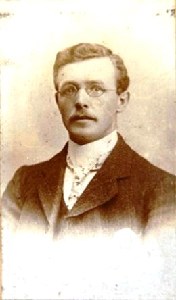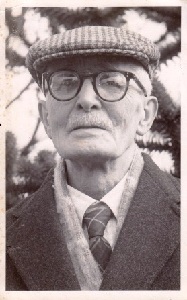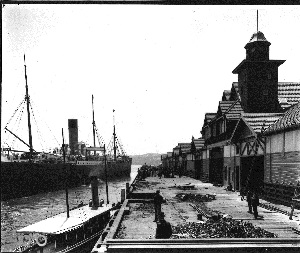
Photo : David Oliver with Thanks
Medal Index Card

Daniel Robinson Oliver circa 1964 Photo : D Oliver

Australian National Maritime Museum SS Medic
Special Constable Police Medals
Mary Jane Kirton had a younger sister called Alice Emily Kirton who had a son called John William Nicholson, [born 1st November 1881]. In 1891 were residing at St Johns Crescent, Darlington, Durham, England. [After Primary School John William Nicholson lived and was educated in Middlesborough until he entered University in Manchester in 1898. After gaining a BSc and later a MSc he moved to Cambridge where he became a Wrangler (ie a graduate in Maths with first class honours). In 1912 he was appointed to Kingís College London as Prof of Mathematics. He became a FRS in 1917. In 1921 he moved to Oxford University as Fellow in Mathematics to Balliol College]. In 1922 he married Dorothy Wrinch who was also a distinguished mathematician. They had one daughter Pamela who was born in 1927. John Nicholson retired due to health reasons in 1930. The marriage was dissolved in 1938 and Dorothy Wrinch moved with her daughter to the USA in 1939 to continue her career in mathematics. Nicholsonís research on 'coronal and nebular spectra' was a stimulus to other researchers in atomic and quantum physics. He died in Oxford in October 1955.
Elizabeth A, born 20th September 1872, Frederick William, born 23rd November 1874, [married on the 15th August 1899, to an Annie Watson, born 28th March 1884], Mary Evelyn, born 1876, Joseph Henry, born 13th February 1879, [residing at 71 Cross Hill, Wortley R.D., Yorkshire (West Riding), in 1939, Clerk to the Parish Council, Widowed], John Bertram, born 24th July 1880, [who by 1939, was Incapacitated, residing with his sister Elizabeth A, at 6 Swinburne Road, Darlington C.B., Durham, England], David Cooper, born 7th June 1884, [married an Ethel M. born 11th October 1889], and Daniel. All were born at 19 Powlett Street West, Darlington.
By 1891 the family have moved to 6 Maude Street, Darlington. Daniel's father Daniel Henry, in 1881 was a clerk in the Water Works, by 1891 he was a Land agent Clerk ending up as a Surveyor by 1901. Elizabeth was a Milliner assistant, before graduating to a Milliner shop woman in 1901, Frederick was a printer's apprentice, prior to becoming an Accountant, Mary Evelyn went on to become an assistant School Mistress, and John was a commercial Clerk for the Borough Council.
In 1901, the family minus Joseph Henry and Frederick William, [who in 1939, was now a retired accountant, and in the Special Constabulary], was residing at 14 Southend Avenue, Darlington with his wife Annie Watson, they had two children, Neville Anderson Prudence Oliver, born 19th September 1904, [in 1939 was residing at 33 Southend Avenue, Darlington C.B., Durham, England, with his wife Elizabeth M. Oliver, born 26th May 1906, and two children, {Anne M, M, Oliver, born 17th August 1930, at school, and Gillian}, a Working Proprietor Of Wholesale Retail Grocery & Provision Business, Fox Brothers Grocery in Bondgate], was also an Air Raid Warden in WW2, died 14th November 1958, and Lewis Vernon Oliver, born 3rd July 1909, Wholesale & Retail Grocery (Own Account), residing at 418 Coniscliffe Road, Darlington C.B., Durham, he was also an Auxiliary Fire man in the A.F.S., in WW2, died 1996], were now residing at 7 Danesbury Terrace, Darlington, before finally residing at 6 Swinburne Road, Darlington, by 1911. David Cooper in 1939 was a Rating and Valuation Officer for the Local Government and was residing at 4 'The Rise', Darlington.
Daniel was educated at the Beaumont Street, Junior, School, then the (senior), at Darlington. From the 13th July 1895, He won the Belasses scholarship, to the Darlington Grammar School, he came first out of 4 possible places, he gained 573 marks out of a possible 750 marks. On the 9th February 1898, he passed 1st Year History. On the 29th August 1898, Daniel commenced as a Monitor aged 16 then, with the intention of taking a shortened apprenticeship of 3 years, after he attended Darlington Grammar School for three years and taking 2nd class Junior honours in the Cambridge local examinations. In 1899 he is listed in his 2nd Year in the school staff Log book. In 1900, 15th February he is now in his third year, 24th January 1901 report well. 22nd February 1901 he came 5th out of 17 with a mark of 64.1%. He finished his apprenticeship in 1901
In the Northern Echo Saturday 12/08/1899. The Darlington Technical College had published the examination results. "Elementary 2nd Class, Daniel Oliver," was amongst those mentioned.
In 1902, May 15th, Daniel was appointed temporarily assistant teacher to replace a Mr Bromley.
Daniel Robinson trained at the University College at Nottingham, he was an Assistant Master at the Forster Street Council School in Nottingham 1904-1905, then at Deanbank Council School at Ferryhil, in 1905 till 1909, then West Benhar Public School at Harthill, Lanarkshire from 1909 to 1914, then the Council Boy's School at Sherburn Hill from 1914 until 1926. In 1912, Daniel married Lillian 'Lily' Ethel, [nee Burghart], [born at Unthank Blue Row, Berwick-upon-Tweed, daughter of Henry and Martha Bughart, baptised on the 18th march 1885], at the Parish Church, in Ferryhill, on the 5th February 1912. They had one child a daughter named Lily Ethel who was born at Cambusnethan on the 31st December 1912.
They were residing at 4 Hudson Street, Ferryhill, Durham. Daniel was 33 years and 9 months old, 5 feet 9 inches tall, when he attested on the 2nd November 1915, at Ferryhill, for the Duration of the War, and on the 4th November, after been given a Railway Warrant, was examined at Aldershot where he was posted into the Army Supply Corps, service number S4/145474, he was in 'A' Company, Supply section, Labour, as a supply clerk in the 4th New Army.
The man served in the Supply section of the ASC. The prefixes SS and S1 to S4 are also often seen. SS means that the man was specially enlisted for his trade: in other words, he came from civilian employment in a trade that was of direct value to work in the Supply section: he may have been a clerk, butcher or baker, for example. S1 to S4 mean that the man was enlisted into the first to fourth New Army depending on the number after the S. If the man has an ES prefix then he was re-enlisted after the war.
He was posted to Southport where there was an A.S.C. depot.
ASC (Southport, Western Command). As well as being a stores and repair depot from December 1916 it became a Discharge Depot (with elements of retraining wounded men for home service) for ASC men returning from the BEF.
He was in the UK until the 27th November 1917.
In April 1916 a Base MT Depot of 201 ranks arrived in Mombasa and set up initially in Nairobi, but moved in September to Dar-es-Salaam.
His wife died on the 11th October 1916, at Rose Villa, 1 Archbold Terrace, Newcastle-upon-Tyne, of Uterine Fibroid, Vaginal Enucleation, Shock - 1 hour.
Given the cause of death it is presumed Lily was admitted to hospital for an operation to remove a fibroid from her uterus. During that operation the fibroid probably ruptured and she haemorrhaged causing loss of blood and she died from hypovolemic shock after 1 hour.
[The definition of enucleation is to surgically remove something whole, and hypovolemic shock is a life threatening condition which results when you lose more than 20% of your bodyís blood supply and the severe loss makes it impossible for the heart to function adequately].
On the 28th November 1917, Daniel embarked on the H. M. T. 'SS. Medic', ship number 110573, at Devonport for the East African Expeditionary Force to Durban. Whilst on this vessel, Daniel is confined to Barracks for three days for not wearing a lifebelt while on Board. On the 7th January 1918 he embarked from Durban via Dar-es-Salaam aboard the Cunard Liner "Caronia". Ship number 120826. During World War I, 'Caronia' first served as an armed merchant cruiser. I have not come across any stories of her time served in this capacity that would rival her sister shipís encounter with Cap Trafalgar but heartily welcome any tales someone might know of. In 1916 she was converted over for troopship duty and served until 1919 when she resumed passenger service. She was sold to Japanese scrappers in 1932. For some reason she was renamed Taiseiyo Maru and sailed for Japan where she was broken up at Osaka in 1933.
Source : Lost Liners [defunct website.
He was attached to the clerical staff of GHQ, with the Deputy Adjutant and Quartermaster General dealing with logistics.
He also was granted additional pay from the 18th February 1918 of 6d, to the 27th June 1918, the difference between the ASC rate and the RE Rate whilst on duty in the Grave Registration Unit.
He eventually was posted into the Army Pay Corps on the 19th September 1918. Service number 24978. He returned home aboard the H. S. Voraurj? to the UK on the 16th February 1919. He was transferred to a Class 'Z' Reserve on the 26th April 1919, at Ripon. Residing at 6 Swinburne Road, Darlington. Classed as B1 Category.
Daniel received the Victory and War Medal for his services. Daniel spent a total of 3 years and 74 days in the Army.
After leaving the army, Daniel continued his teaching career, and Daniel was registered on the 1st June 1920, number 35947, with the Teachers Registration Council and was became headmaster at the Sadberge Church of England Mixed School, from 1926, which no longer exists today.
Daniel, still a schoolmaster, remarried in 1925, Ann Isabella Chalmers, [born 6th September 1892, at Strichen]. In 1939, they were residing at 'The Neuk' Chapter Row, Darlington, he was also a Special Constable for Durham County Council. They had two children David Oliver, born 12th August 1932, in Aberdeen, who emigrated to Australia in 1962, and a daughter June, [who married a Swedish man], who was born in Sadberge on 10th June 1928, [she had worked at the Darlington War Memorial Hospital for a short time], subsequently in London than the West Indies, who emigrated to Sweden in 1954.
Daniel retired and moved to Abbey St Bathans, Berwickshire, in 1947, where Ann Isabella, his wife, obtained a position as a sole teacher in the village. When she retired in 1957, they moved to Inverness.
Footnote: Special Constables were entitled to medals. However, they were not always issued, as payment by their wages was often sufficient. They were not guaranteed to entitlement, with over 600 different police forces then, there was no central list.
Contact the North East Police History Society. Special Police Constables played a vital role in our region during World War Two. Many were veterans of the First World War just twenty years earlier. They served their country in its hour of need and their good work was recognised with the Long Service Medal. The only problem was that not all of the volunteers got their medals, until now. See Medals Found.
A forgotten batch were recently discovered in a store room at Northumbria Police Headquarters in Ponteland. Now the North East Police History Society want them see them go to the families of the heroes.
Darlington was the HQ location of the Auxiliary Units. See Darlington. Well known, in the North East that the actor, Captain, John Anthony Quayle visited the North East in his role as Intelligence Officer for the Auxiliary Units.
The story of the Auxiliary Units
Research : David Oliver/James Pasby
David Oliver, the son of Daniel Robinson Oliver, now living in Australia, submitted this : I found this site today (06/09/2017) which lists the names of Servicemen from Co Durham in WWI. My father Daniel Robinson Oliver, who was a teacher, enlisted on 6th November 1915. His address at that time was 4 Hudson Street, Ferryhill. His wife at that time, Lilian Ethel, died in October 1916. Later in the war my father served in East Africa.
My sister and I spent our primary school years in Sadberge and eventually went to University, both to do Medicine, my sister in Aberdeen, I in Edinburgh. My sister eventually became an Anaesthetist and I an Obstetrician and Gynaecologist. We both emigrated, my sister to Sweden and I to Australia.
There is a tinge of sadness when one learns of "progress". Sadberge CoE school is no longer a school, indeed, I believe that there is no longer a school in Sadberge. The Sadberge War Memorial Hall, of which I found mention on the website, no longer exists either. During WWII, when there was a busy RAF airfield at Goosepool (now Teesside Airport I think,) there were frequent 'Whist Drive and Dance' evenings in that hall to which the airmen would turn up. It was also the venue for many village celebrations of one sort or another. Sadly I have no photographs, merely memories!
These stumbles across memorabilia conjure up many nostalgic memories. I attach one piece of my collection of memorabilia of my father which I have found on the net.
I was surprised to find another item whilst browsing through your web site today, namely "Second World War Resistance". I remember one day during WWII that two gentlemen came to talk with my father (in Sadberge). They were ushered in to our sitting room and held some sort of important (hush-hush) discussion although no mention of it was made to us children. I remember at a later date discovering some coloured illustrations of the insignia of German Regiments. I was not supposed to have seen them of course (I was a young inquisitive boy!)
After the war my father told me that the particular meeting had been to recruit him in to "The Resistance". I think he told me that one of the two gentlemen had come from Sedgefield. Did Capt Atkinson come from Sedgefield? He told me something to the effect that as a member of the resistance he was responsible for a square of territory and that he knew the names of only four other people in the organisation each bordering one side of that square. In this way no member would be able to divulge too many names of the fellow members in the event that they were interrogated/tortured. The reference on your web page is the first which I have ever seen to confirm my memory of a British Resistance movement. I had wondered if it was a figment of my imagination.
When my father joined the Army in WWI he joined the Army Service Corps and later, whilst in East Africa, was transferred to the Army Pay Corps.
As a boy playing during the years of WWII, we would mimic The Home Guard, or references to regiments of which we heard on the news or saw in the cinema (Gaumont British News). Most of us had some sort of memorabilia from parents or uncles who had served in WWI. The memorabilia which I could sport included a solar topee from my father's service in East Africa!
Most people are unaware of the East African campaign which tied up many servicemen in their campaign against German soldiers and the native African soldiers, Askaris, led by Col Paul von Lettow-Vorbeck. Tanganyika had been a German Colony, German East Africa. Those same people, unaware of that campaign, may however have heard of the film starring Humphrey Bogart (who won an Oscar) and Katherine Hepburn entitled The African Queen which was set in the midst of that East African campaign. The East African campaign began in 1914 at the outbreak of the war and did not cease until November 25th 1918 for by that time von Lettow-Vorbeck was conducting guerrilla warfare and was unaware that the war had officially finished earlier in November. The Allied Troops were under the command of Jan Smuts who later became the South African President.
Regards David Oliver
British Resistance Archive
History of the Police Special Constables
WW1 Diary in East Africa.
RASC Museum

